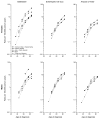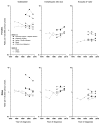Biliary tract cancer incidence in the United States-Demographic and temporal variations by anatomic site
- PMID: 23504585
- PMCID: PMC3713194
- DOI: 10.1002/ijc.28161
Biliary tract cancer incidence in the United States-Demographic and temporal variations by anatomic site
Abstract
We evaluated incidence patterns of biliary tract cancers (gallbladder, extrahepatic bile duct, ampulla of Vater and not otherwise specified) to provide potential insight into the etiology of these cancers. Data were obtained from the population-based Surveillance, Epidemiology and End Results program. Rates for cases diagnosed during 1992-2009 were calculated by racial/ethnic, gender and age groups. Temporal trends during 1974-2009 and annual percentage changes (APC) during 1992-2009 were estimated. Age-adjusted rates by site were higher among American Indian/Alaska Natives, Hispanics (white) and Asian/Pacific Islanders (Asian/PI) and lower among whites and blacks. Gallbladder cancer was more common among women in all ethnic groups (female-to-male incidence rate ratio [IRR] ranged from 1.24 to 2.86), but bile duct and ampulla of Vater cancers were more common among men (female-to-male IRR 0.57 to 0.82). Gallbladder cancer rates declined among all racial/ethnic and gender groups except blacks (APC -0.4% to -3.9%). In contrast, extrahepatic bile duct cancer rates rose significantly in most female racial/ethnic groups; the APCs among whites were 0.8 among females and 1.3 among males, both significant. Rates for ampulla of Vater cancer decreased among Asian/PI females (APC -2.7%) but remained stable for the other groups. In addition to confirming that biliary tract cancer incidence patterns differ by gender and site and that the gallbladder cancer incidence rates have been declining, our study provides novel evidence that extrahepatic bile duct cancer rates are rising. These observations may help guide future etiologic studies.
Keywords: Klatskin tumors; ampulla of Vater cancer; biliary tract cancer; extrahepatic bile duct cancer; gallbladder cancer; incidence.
Published 2013. This article is a US Government work and, as such, is in the public domain of the United States of America.
Conflict of interest statement
The authors declare no other conflict of interest.
References
-
- Howlader NNA, Krapcho M, Neyman N, Aminou R, Altekruse SF, Kosary CL, Ruhl J, Tatalovich Z, Cho H, Mariotto A, Eisner MP, Lewis DR, Chen HS, Feuer EJ, Cronin KA, editors. SEER Cancer Statistics Review, 1975–2009 (Vintage 2009 Populations) National Cancer Institute; Bethesda, MD: 2012. http://seer.cancer.gov/csr/1975_2009_pops09/, based on November 2011 SEER data submission, posted to the SEER web site, April 2012.
-
- Hsing A, Rashid A, Devesa S, Fraumeni JJ. Biliary Tract Cancer. In: Schottenfeld D, Fraumeni JF Jr, editors. Cancer Epidemiology and Prevention. 3. New York: Oxford University Press, Inc; 2006. pp. 787–800.
-
- Randi G, Franceschi S, La Vecchia C. Gallbladder cancer worldwide: geographical distribution and risk factors. Int J Cancer. 2006;118:1591–602. - PubMed
-
- Goodman MT, Yamamoto J. Descriptive study of gallbladder, extrahepatic bile duct, and ampullary cancers in the United States, 1997–2002. Cancer Causes Control. 2007;18:415–22. - PubMed
-
- Le MD, Henson D, Young H, Albores-Saavedra J. Is gallbladder cancer decreasing in view of increasing laparoscopic cholecystectomy? Ann Hepatol. 2011;10:306–14. - PubMed
Publication types
MeSH terms
Grants and funding
LinkOut - more resources
Full Text Sources
Other Literature Sources
Research Materials
Miscellaneous



